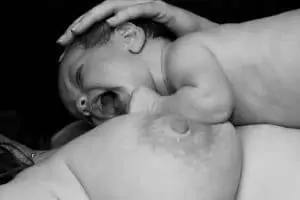Rooting and sucking are natural reflexes all babies have at birth, but you might not know that there are two types of sucking: nutritive and non-nutritive sucking. Both serve a purpose for your baby, so it’s essential that you learn the differences and why your baby has different sucking modes.
Chances are you noticed the desire to suck as soon as your baby was born. Babies root on their mothers, looking for the breast. They might try to suck on your arm, face, or side of your breast. The drive to suck is real; sucking is how babies relax and self-soothe. Entering this new world leads to overstimulation and higher cortisol levels, and sucking helps your baby relax.
Let’s take a look at the two different types of sucking and why your baby has those desires.
Nutritive vs. Non-Nutritive Sucking
When you’re breastfeeding, you might notice that your baby’s sucking changes. That’s because there are different stages for breastfeeding, and non-nutritive breastfeeding feels unusual and serves a different purpose than nutritive nursing.
Nutritive suckling is when your baby breastfeeds to transfer milk from your breast into their stomach. When your baby is hungry and actively suckling while swallowing, you know that your baby is nutritive sucking. He’s filling his belly.
The pattern of nutritive sucking continues as long as the milk is available and your baby is hungry. The average is one suck per second, leading to a high milk flow at this time.
Non-nutritive sucking requires that your baby suckles differently. Your baby is still nursing, but they’re full, so it’s only as a form of comfort. Your nipple is the original pacifier, and that’s what this type of suckling does. When your baby is tired and wants to fall asleep, he changes his suckle to stop the milk flow but still satisfies the suckling reflex.

Non-nutritive suckling may happen at a few different times.
- When your baby is full but at the breast
- At the end of a feeding
- Between nutritive sucks
One of the differences between nutritive and non-nutritive sucking is that the pattern doesn’t repeat quickly or continuously. The process is slower, with your baby taking periods of rest. Your baby will pull milk from the breast, but it takes many sucks to gather an amount worthy of swallowing.
Essentially, the best way to describe this type of suckling is that your baby is using your breast as a pacifier. Welcome to being a human pacifier.
Is Non-Nutritive Sucking Good or Bad While Breastfeeding?

While this type of suckling serves a purpose, it leaves you wondering whether or not you should let your baby continue to suck without removing milk. The answer is a bit complicated and not black and white for all women.
Anytime you bring your baby to your breast, it stimulates your milk glands to create more milk and increase the hormones needed to produce the necessary amount of breast milk. Even if your baby isn’t nursing for milk, he still ends up swallowing more than intended because some milk escapes.
Some possible problems that might come from chronic non-nutritive sucking include:
- Adverse effects on the mother’s mental and physical well-being.
- Sore or cracked nipples
- Engorged breasts
- Oversupply of breast milk
- Potential for clogged ducts and mastitis
Non-Nutritive Sucking is More than Nursing
Even if your baby doesn’t breastfeed, he can still partake in this form of suckling. All babies are born with the need to suck.
For bottle-fed babies, sucking on pacifiers and fingers is considered a form of non-nutritive sucking. They both satisfy the need for sucking to soothe and calm the baby. Many babies have a stronger desire to suckle, so providing an opportunity for them to do so helps decrease stress and relax your baby.
Please note that:
The problem with using pacifiers or allowing your baby to suck on his thumb (or fingers) leads to habit-forming behaviors that could have adverse effects on their teeth and mouth development. Short-term use is normal, but extended suckling could cause problems. Speak to your doctor if you have worries or concerns.
Non-Nutritive Sucking is Normal
The most important thing to remember is that all babies have a drive for non-nutritive sucking; sucking and rooting are necessary reflexes for new babies. It’s how they calm and relax after a dramatic entrance to this world. If your baby has a desire to suck to soothe, allow them to do so within reason.
Hey, this is Linda. My biggest accomplishment in life is being a mother of four children. Their current ages range from almost ten years old down to 20 months old.
I’m passionate about writing parenting articles because I understand so well all of the problems and trials you face as a parent. From breastfeeding woes to budgeting problems and behavior problems, along with everything in between, chances are I’ve faced it over the last ten years. Read more about Linda here.






